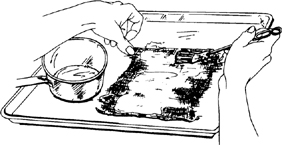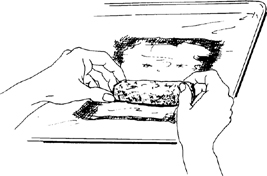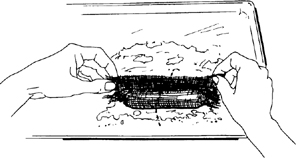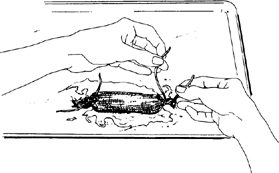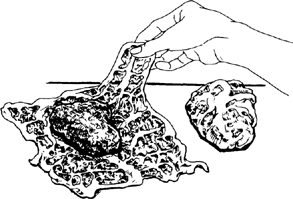Mastering the Art of French Cooking, Volume 2 (123 page)
Read Mastering the Art of French Cooking, Volume 2 Online
Authors: Julia Child

HOW TO FORM SAUSAGES IN CHEESECLOTH CASINGS
Cheesecloth works very well indeed as an alternative to professional casing when it is of no aesthetic importance that the sausage be perfectly symmetrical, such as those to be baked in pastry, served in slices, or crumbed and broiled. The following illustrations are for small sausages; large ones are formed in the same way.
As an example, for 5-inch sausages, provide yourself with sufficient pieces of well-washed, damp, double-thickness cheesecloth about 8 inches square, and sufficient 4-inch pieces of white string to secure the 2 ends of each. Form sausages one at a time. |
|
| Form a neat rectangular loaf of sausage meat 5 inches long on lower end of cheesecloth. |
Smooth meat into a cylindrical shape; roll up tightly and neatly in cheesecloth. |
|
| Tie one end securely with white string. Twist other end of cheesecloth to pack meat into place, |
CAUL FAT
A marvelously useful product of the hog is its caul fat (
crêpine, toilette
), the spider-web-like membrane laced with fat that lines the visceral cavity. Caul fat makes a perfect and perfectly edible container for the fresh sausage patties called
saucisses plates
or
crêpinettes.
You can use caul fat instead of casing for
boudins,
for the large sausages you bake in
brioche
dough, and it is marvelous for wrapping up the
stuffed tenderloin
, meats roasted in a cloak of mushroom
duxelles,
or the
noisettes de veau
. Although American manufacturers use it for the occasionally made Devonshire sausages, caul fat is so little known to the general public in this country that unless you have a European butcher in your shopping area, you will have to order it. As caul fat will keep 2 months or more in the freezer, get several pieces while you are at it; each will average 30 inches square.

